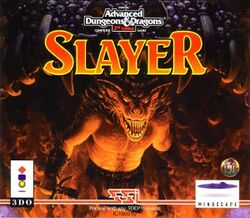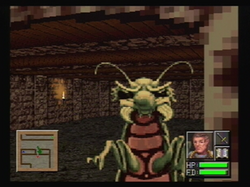Software:Advanced Dungeons & Dragons: Slayer
| Advanced Dungeons & Dragons: Slayer | |
|---|---|
 North American cover art by Keith Parkinson | |
| Developer(s) | Lion Entertainment |
| Publisher(s) |
|
| Director(s) | Ronald Bolinger |
| Producer(s) | Douglas Grounds |
| Programmer(s) | Glen Merriman |
| Artist(s) | Daniel Bourbonnais |
| Composer(s) | Billy Wolfe |
| Series | Dungeons & Dragons |
| Platform(s) | 3DO |
| Release | |
| Genre(s) | Dungeon crawl, action role-playing |
| Mode(s) | Single-player |
Advanced Dungeons & Dragons: Slayer is a fantasy first-person, dungeon crawl / action role-playing game based on the second edition of Advanced Dungeons & Dragons. The game was developed by Lion Entertainment and published by Strategic Simulations in 1994 for the 3DO Interactive Multiplayer. A Japanese version titled Lost Dungeon (ロストダンジョン) was published by T&E Soft the following year.
Gameplay
Slayer features a customizable dungeon generator so each time the player starts the game, they are faced with a new dungeon. The dungeon always ends with a boss floor, randomly selected from several possible bosses. When starting a new game, the player may either create a custom character with randomly generated stats, pick from a selection of preset characters, or reuse a previously created character. The game may be saved at any time, but is limited to a single save slot.
Development and release
Slayer was developed as part of a contract between video game corporation SSI and TSR, the owner and publisher of the tabletop role-playing game Dungeons & Dragons. SSI had previously used the license to adapt the property into a number of notable games including Pool of Radiance, the Gold Box series, and Eye of the Beholder.[3] For Slayer, SSI gave development duties to Lion Entertainment, an Austin, Texas -based studio founded by Douglas Grounds in June 1993.[4] Grounds was also a producer at The 3DO Company's Austin office.[5] Lion Entertainment's principle staff for Slayer consisted of director Ronald Bollinger; programmer Glen Merriman; music composer Billy Wolfe; sound editor Geoffrey Sanders; art director Daniel Bourbonnais; and artists Daniel Bourbonnais, Martin Thomas, Sara Farr, and Rebecca Price. Grounds served as executive producer while assisting on programming. The game's 3D modeling and rendering were done by Grounds, Bollinger, and Sanders.[6]
Slayer was released exclusively for the 3DO Interactive Multiplayer by SSI in North America in September 1994[1] and by SSI's parent company Mindscape in Europe in 1995. The game was published by T&E Soft in Japan on January 20, 1995 under the title Lost Dungeon.[2] Computer Gaming World reported months ahead of the game's scheduled launch that SSI and TSR were dissolving their partnership and that Slayer would be one of the last products in that agreement.[3] A version for the PlayStation was announced for an October 1995 release but never materialized.[7][8] SSI and Lion Entertainment did collaborate on a sequel to Slayer titled Advanced Dungeons & Dragons: DeathKeep, released on 3DO in 1995 and Windows in 1996.[9][10] Lion Entertainment went on to port several popular first-person shooters including Doom II, Duke Nukem 3D, and Quake to Macintosh before voluntarily closing in 1999.[4][11][12]
Reception and legacy
| Reception | ||||||||||||||||||||||||||||
|---|---|---|---|---|---|---|---|---|---|---|---|---|---|---|---|---|---|---|---|---|---|---|---|---|---|---|---|---|
| ||||||||||||||||||||||||||||
| ||||||||||||||||||||||||||||
GamePro gave the game a generally positive review, saying it successfully combines fast-paced action in a Wolfenstein 3D vein with traditional RPG gameplay. They criticized the music and lack of sound effects, but praised the abundance of options and the varied dungeon layouts, and commented that the adjustable difficulty make the game appropriate for players of all ages.[15]
Next Generation was generally negative to the game and gave it 2 stars out of 5.[21]
Allen Rausch for GameSpy called Slayer "a fantastic game" for how rare it is, and that it "was actually one of the better games" for the 3DO system.[29]
Concordia University professor and author Mark J. P. Wolf noted Slayer as an example of a game that utilizes handcrafted assets (including walls, doors, and windows) to give each of its dungeons a deliberate feel in their design despite a reliance on random, procedural generation for their layouts.[30]
References
- ↑ 1.0 1.1 EGM staff (October 1994). "Fact Files: Slayer". Electronic Gaming Monthly (Sendai Publications) (45): 214. ISSN 1058-918X. https://archive.org/details/Electronic_Gaming_Monthly_63_October_1994_U/page/n219/.
- ↑ 2.0 2.1 "ロストダンジョン" (in ja). Famitsu (Kadokawa Game Linkage). https://www.famitsu.com/cominy/?m=pc&a=page_h_title&title_id=20812&redirect=no. Retrieved August 6, 2022.
- ↑ 3.0 3.1 CGW staff (April 1994). "SSI Advances Beyond D&D With Divorce From TSR". Computer Gaming World (Ziff Davis) (112): 12. ISSN 0744-6667. https://archive.org/details/Computer_Gaming_World_Issue_117/page/n11/.
- ↑ 4.0 4.1 "LION ENTERTAINMENT, INC.". OpenCorporates. https://opencorporates.com/companies/us_tx/0127262400. Retrieved August 12, 2022.
- ↑ Strauss, Barry (October 19, 2011). "Aggregate Knowledge Names Former Adobe Executive Douglas Grounds as Senior Vice President, Customer Success". Business Wire. https://www.businesswire.com/news/home/20111019005504/en/Aggregate-Knowledge-Names-Former-Adobe-Executive-Douglas-Grounds-as-Senior-Vice-President-Customer-Success. Retrieved August 12, 2022.
- ↑ SSI staff (1994). Advanced Dungeons & Dragons: Slayer instruction manual. Strategic Simulations, Inc.. p. 57.
- ↑ GamePro staff (Spring 1996). "PlayStation: Slayer". The Cutting Edge: Presented by GamePro Magazine (IDG): 65. ISSN 1042-8658. https://archive.org/details/GamePro_The_Cutting_Edge_Spring_1996/page/n69/.
- ↑ Game Players staff (October 1996). "In The Works". Game Players (Imagine Media) (76): 37. ISSN 1042-3133. https://archive.org/details/Game_Players_Issue_57_October_1995/page/n40/.
- ↑ Next Generation staff (March 1996). "Deathkeep". Next Generation (Imagine Media) (15): 84. ISSN 1078-9693. https://archive.org/details/NEXT_Generation_15/page/n87/.
- ↑ SSI staff (May 27, 1996). "SSI: Press Releases: DUNGEON DELVING DELIRIUM!!!". http://www.ssionline.com/cgi-bin/omixlink?709815180+insider/press_releases/pr_dthkp.html.
- ↑ Johnston, Chris (April 26, 2000). "Mac Gamers Lose Lion". CBS Interactive. https://www.gamespot.com/articles/mac-gamers-lose-lion/1100-2467151/. Retrieved August 12, 2022.
- ↑ Fish, Eliot (October 1997). "News: The Lion Sleeps Tonight". Hyper (nextmedia) (48): 14. ISSN 1320-7458. https://archive.org/details/hyper-048/page/14/.
- ↑ Guise, Tom (January 1995). "Review: Slayer". Computer and Video Games (Future plc) (158): 98. ISSN 0261-3697. https://retrocdn.net/images/thumb/8/84/CVG_UK_158.pdf/page98-836px-CVG_UK_158.pdf.jpg. Retrieved August 11, 2022.
- ↑ EGM staff (November 1994). "Review Crew: AD&D Slayer". Electronic Gaming Monthly (Sendai Publications) (46): 46. ISSN 1058-918X. https://archive.org/details/ElectronicGamingMonthly_201902/Electronic%20Gaming%20Monthly%20Issue%20064%20%28November%201994%29/page/n45/mode/2up.
- ↑ 15.0 15.1 Scary Larry (December 1994). "Role-Player's Realm: Slayer". GamePro (IDG) (65): 204–6. ISSN 1042-8658.
- ↑ Ellis, Les (February 1995). "Slayer". GamesMaster (Future plc) (26): 67. ISSN 0967-9855.
- ↑ Belin, Stéphane (October 1994). "Test: Slayer". Génération 4 (Pressimage) (71): 128–9. ISSN 1624-1088. https://archive.org/details/generation4-magazine-071/page/n127/mode/2up.
- ↑ MAN!AC staff (November 1994). "Import: Slayer". MAN!AC (Cybermedia) (13): 34. OCLC 645800887. https://archive.org/details/MANIAC.N013.1994.11/MANIAC.N013.1994.11-DURiAN/page/n33/.
- ↑ Joystick staff (October 1994). "Vidéotest - Slayer". Joystick (Hachette Digital Presse): 93. https://archive.org/details/joystick053/page/n92/mode/1up?view=theater. Retrieved August 10, 2022.
- ↑ Gößmann, Holger (August 1995). "Test Kunterbunt: Slayer". Mega Fun (Mega Fun) (35): 68. ISSN 0946-6282. https://www.kultboy.com/index.php?site=t&id=21267.
- ↑ 21.0 21.1 Next Generation staff (January 1995). "Finals: Slayer". Next Generation (Imagine Media) (1): 92. ISSN 1078-9693. https://archive.org/details/NextGeneration01Jan1995/page/n97/.
- ↑ Video Games staff (July 1995). "Reviews: Slayer" (in German). Video Games (Magna Media): 96. ISSN 0946-0985. https://retrocdn.net/images/thumb/e/e7/VideoGames_DE_1995-07.pdf/page96-416px-VideoGames_DE_1995-07.pdf.jpg. Retrieved August 9, 2022.
- ↑ VideoGames staff (December 1994). "Capsule Reviews: Slayer". VideoGames - The Ultimate Gaming Magazine (L.F.P., Inc.) (71): 132. ISSN 1059-2938. https://archive.org/details/Video_Games_The_Ultimate_Gaming_Magazine_Issue_71_December_1994/page/n130/. Retrieved August 9, 2022.
- ↑ Wynne, Stuart (January 1995). "Review: Slayer". 3DO Magazine (Paragon Publishing) (1): 37. ISSN 1355-9621. https://archive.org/details/3DOMagazineIssue10199605ParagonPublishingGB/3DO%20Magazine%20%2301%20%281994-12%29/page/n46/mode/1up?view=theater.
- ↑ Ação Games staff (October 1994). "Slayer" (in PT). Ação Games (Brazil: Editora Abril) (69): 34. ISSN 0104-1630. https://archive.org/details/acaogames147janeiro2000poster/A%C3%A7%C3%A3o%20Games%20%23069%20%28Outubro%201994%29/page/n33/.
- ↑ D'Aprile, Jason (January 1995). "Virtual Worlds: Slayer". Electronic Entertainment (Infotainment World) (13): 90–1. ISSN 1074-1356. https://archive.org/details/ElectronicEntertainment13Jan1995/page/n91/.
- ↑ Yates, Laurie (December 1994). "CD-ROM: Slayer". Electronic Games (Decker Publications) 3 (3): 180–1. ISSN 0730-6687. https://archive.org/details/electronic-games-1994-12/page/180/.
- ↑ EG Editorial Staff (May 1995). "1995 Gaming Awards". Electronic Games (Decker Publications) 3 (8): 35. ISSN 0730-6687. https://archive.org/details/electronic-games-1995-05/page/34/.
- ↑ Rausch, Allen (August 18, 2004). "A History of D&D Video Games - Part IV". IGN. Archived from the original. Error: If you specify
|archiveurl=, you must also specify|archivedate=. https://web.archive.org/web/20220706164409/http://pc.gamespy.com/articles/540/540115p1.html. - ↑ Wolf, Mark J.P. (September 27, 2019) (in en). Ludotopia: Spaces, Places and Territories in Computer Games. Media Series. 63. Bielefeld: transcript Verlag. pp. 300. ISBN 978-3-8376-4730-3. https://archive.org/details/ludotopia-games/page/300/mode/1up.
External links
 |


